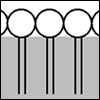Session Overview
|  |
This session will introduce the structure of biological molecules and the molecular forces involved in the formation of these molecules. Learning Objectives
|
Session Activities
Lecture Video
Watch the lecture video excerpt
Check Yourself
Question 1
Which of the following type of bond or interaction joins monomers together to form biological polymers?
Question 2
Which of the following does not accurately describe a covalent bond?
Session Activities
Help Session Video
Watch the short video of Nicole DeNisco explaining covalent bonds, chirality, electronegativity, and hydrogen bonding, that refers to the practice problem below.
Practice Problems
Further Study
Suggested topics for further study in an introductory-level Biology textbook
- Forces: covalent bonds, ionic bonds, hydrogen bonds, van der Waal’s forces, and hydrophobicity
- Catalysts
- Chirality
- Polarity










